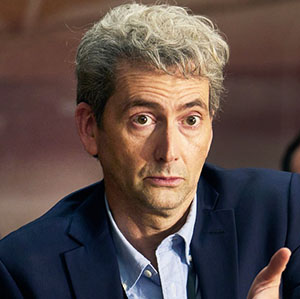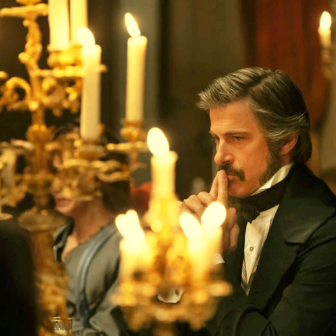Bram Stoker’s Dracula (1897) may be the origin story for the ever-proliferating vampire dramas in modern popular culture, but it is saturated with its own prehistory. Dating back many centuries in the folklore traditions of Eastern Europe, the myth of the vampire was given to plague-like outbreaks, recorded in local accounts of desperate attempts to deal with the undead.
Stoker’s Count Dracula may not be the source, but he is the superspreader, and the compulsion to return to him again and again has gripped successive generations. Brought into the cinematic era by Max Schreck in Nosferatu (1922) and carried through the mid twentieth century by Christopher Lee, he made television history when Louis Jourdan inherited the mantle in the 1977 BBC production. Variants have proliferated since then, with The Twilight Saga (2002–12) threatening to eclipse its origins altogether.
In a time of pandemic, conditions are ripe for the Prince of Darkness to reassert his dominance. Right on cue, scriptwriters Mark Gatiss and Steven Moffat, with producer Sue Vertue — the team responsible for bringing Sherlock Holmes into the twenty-first century — have collaborated to take Dracula back to the nineteenth for a new three-part BBC series on Netflix.
As with Sherlock, Gatiss and Moffat draw characters and situations from the literary classic but then license themselves to invent, exploring tangents from the original storylines to take the dramatisation in unexpected and sometimes wayward directions. Reflecting the structure of Stoker’s novel, their three movie-length episodes explore the distinct stages of the Dracula saga: the arrival of young London lawyer Jonathan Harker at the castle in Transylvania, Dracula’s sea voyage to England, and the culminating dual between Dracula and crusading vampire killer Van Helsing.
Much of the impact of the original story derives from its portrayal of Harker’s journey from Victorian London into the wild and uncanny terrain of the Carpathian Mountains, a cultural transition vividly captured by Frances Ford Coppola in his 1992 film. Gatiss and Moffat choose to skip the journey, concentrating on Harker’s arrival at the castle, a location that admittedly carries all the required dramatic impact.
Gatiss, a self-confessed Dracula buff, travelled through Eastern Europe in quest of the original sites, and chose Orava, a castle “jutting like a fang” out of perpendicular rock above the village of Oravsky in Slovakia. The place carries cinematic heritage from its use as the setting for Nosferatu, and cinematographer Tony Slater Ling adds exaggerated vertiginous dimensions that evoke the Wagnerian glamour of Neuschwanstein.
This is a place in which the straitlaced Victorian Englishman will lose himself in every sense. It’s a cultural and psychological meltdown as well as a mortal encounter with a virtuoso in the art of blood transfusion. I wish I could say that it is also scary, as the scriptwriters claim, but therein lies the essential weakness of this ambitious and in many respects brilliant reinvention of the legend.
The actors are not the problem. John Heffernan as the young Jonathan Harker opts for a lawyerly persona rather than the bland young romantic typically portrayed in movie adaptations. Danish actor Claes Bang, who was wonderfully unnerving in Ruben Östlund’s 2017 film The Square, brings appropriate charisma to the title role: seductive and repellent, sharp-witted, debonair and primordially gross by turns, he does much to sustain the dramatic edge of the story when the writers begin to steer it all over the road.
The twists and turns are not always misjudged. Those who have ploughed through the middle section of Stoker’s novel will know that Van Helsing, spouting endless sermons in a Dutch accent rendered with laborious phonetic inaccuracy, is one of the most tedious characters in literature. The decision to create a new kind of adversary for Dracula is welcome.
Dolly Wells as a nun driven by some curious academic interests and a psychological acuity in advance of her time makes a dynamic sparring partner at times reminiscent of the revamped Sherlock. There’s some genuinely smart repartee between the adversaries, but as she and Dracula make a transition to the twentieth century for the final conflict, the writers well and truly lose the plot. Dracula may indeed be seen as a Time Lord, as they insist, but does he really have to morph into yet another Doctor?
The problem with Time Lords in the Gatiss/Moffat repertoire (the duo have written scripts for four of the most recent Doctors) is that they have no commitment to history or to the sense of an epoch. Because they’re bound by no social or linguistic conventions, the period trappings are essentially set decoration.
The second episode, set aboard the ship carrying Dracula’s cargo of coffins, does make a sustained commitment to time and place to conjure a highly charged atmosphere. Photographed by Julian Court, its interior scenes draw on the lighting and colour palette of Joseph Wright, and the seascapes evoke Turner. As they realise what has found its way among them, society passengers and rough crew members, “all in the same boat,” are forced into close collaboration. No magic realism comes to their aid this time.
As in all great stories, the constraints of society and culture are the source of dramatic tension in the original Dracula. Stoker himself, a city businessman, was a product of such constraints, and his association with the great actor Henry Irving, undoubtedly the model for the Count, began when Irving mesmerised the company at a dinner party with his recital of the “ghastly story” of a guilt-stricken murderer.
Irving’s theatre was all about the allure of partially illuminated darkness in a world fascinated with the limits of human knowledge. Fear was generated from what lies outside the circle, though, and however cleverly Gatiss and Moffat play with the image of a Dracula kept outside a literal circle, they just don’t have what it takes to make him frightening.
This is precisely because, assisted by all the innovations of contemporary television image making, they take such unlimited licence with his story. Why accept limits? The vampire, after all, breaches the limits of mortality. Yet he can’t bear sunlight, or crucifixes, or garlic. It’s these restrictions that generate the story’s suspense.
Without observing limits, you end up with all plot and no story. It’s a crucial distinction. Writers create plots by experimenting with what they can make happen, but stories arise from the difficulties people have in making things happen, or preventing what seems inevitable.
“Reality is overrated,” Dracula says more than once in this latest incarnation. But there’s the rub. Where there is too little reality, there can be no real fear. •




